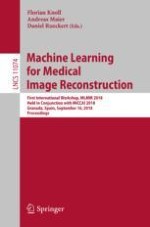2018 | Book
Machine Learning for Medical Image Reconstruction
First International Workshop, MLMIR 2018, Held in Conjunction with MICCAI 2018, Granada, Spain, September 16, 2018, Proceedings
Editors: Florian Knoll, Prof. Dr. Andreas Maier, Daniel Rueckert
Publisher: Springer International Publishing
Book Series : Lecture Notes in Computer Science
